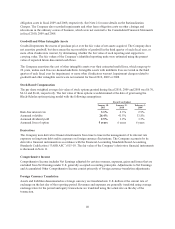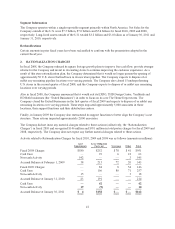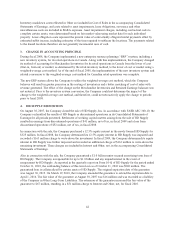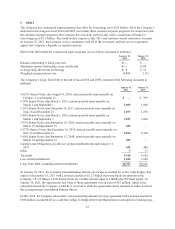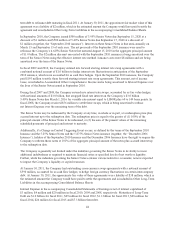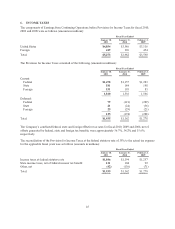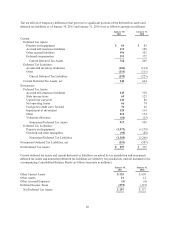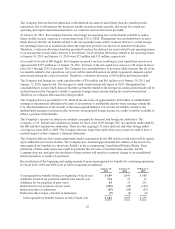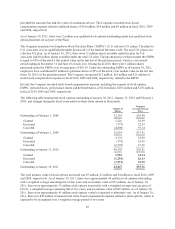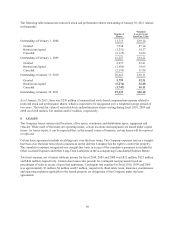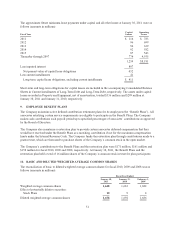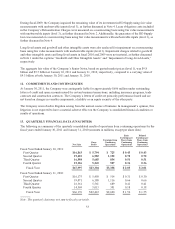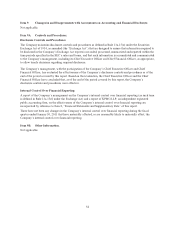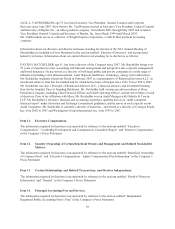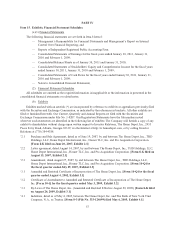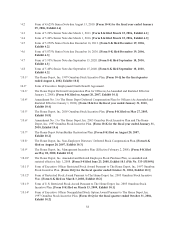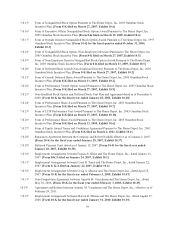Home Depot 2010 Annual Report Download - page 55
Download and view the complete annual report
Please find page 55 of the 2010 Home Depot annual report below. You can navigate through the pages in the report by either clicking on the pages listed below, or by using the keyword search tool below to find specific information within the annual report.
provided the associate has had five years of continuous service. The Company recorded stock-based
compensation expense related to deferred shares of $14 million, $14 million and $9 million in fiscal 2010, 2009
and 2008, respectively.
As of January 30, 2011, there were 2 million non-qualified stock options outstanding under non-qualified stock
option plans that are not part of the Plans.
The Company maintains two Employee Stock Purchase Plans (“ESPPs”) (U.S. and non-U.S. plans). The plan for
U.S. associates is a tax-qualified plan under Section 423 of the Internal Revenue Code. The non-U.S. plan is not
a Section 423 plan. As of January 30, 2011, there were 11 million shares available under the plan for U.S
associates and 20 million shares available under the non-U.S. plan. The purchase price of shares under the ESPPs
is equal to 85% of the stock’s fair market value on the last day of the purchase period, which is a six-month
period ending on December 31 and June 30 of each year. During fiscal 2010, there were 3 million shares
purchased under the ESPPs at an average price of $26.50. Under the outstanding ESPPs as of January 30, 2011,
employees have contributed $7 million to purchase shares at 85% of the stock’s fair market value on the last day
(June 30, 2011) of the purchase period. The Company recognized $13 million, $10 million and $11 million of
stock-based compensation expense in fiscal 2010, 2009 and 2008, respectively, related to the ESPPs.
In total, the Company recorded stock-based compensation expense, including the expense of stock options,
ESPPs, restricted stock, performance shares and deferred shares, of $214 million, $201 million and $176 million,
in fiscal 2010, 2009 and 2008, respectively.
The following table summarizes stock options outstanding at January 30, 2011, January 31, 2010 and February 1,
2009, and changes during the fiscal years ended on these dates (shares in thousands):
Number of
Shares
Weighted
Average Exercise
Price
Outstanding at February 3, 2008 52,365 $38.98
Granted 5,226 26.09
Exercised (777) 22.55
Canceled (4,800) 39.14
Outstanding at February 1, 2009 52,014 $37.91
Granted 4,174 23.29
Exercised (374) 24.50
Canceled (6,505) 37.65
Outstanding at January 31, 2010 49,309 $36.81
Granted 3,723 32.24
Exercised (1,294) 26.63
Canceled (7,271) 43.95
Outstanding at January 30, 2011 44,467 $35.56
The total intrinsic value of stock options exercised was $9 million, $1 million and $4 million in fiscal 2010, 2009
and 2008, respectively. As of January 30, 2011, there were approximately 44 million stock options outstanding
with a weighted average remaining life of four years and an intrinsic value of $51 million. As of January 30,
2011, there were approximately 33 million stock options exercisable with a weighted average exercise price of
$38.21, a weighted average remaining life of two years, and an intrinsic value of $49 million. As of January 30,
2011, there were approximately 41 million stock options vested or expected to ultimately vest. As of January 30,
2011, there was $45 million of unamortized stock-based compensation expense related to stock options, which is
expected to be recognized over a weighted average period of two years.
49



